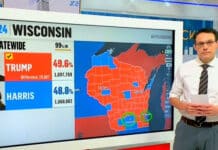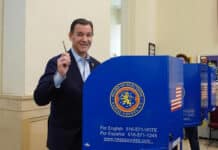Minnesota has been described as both a red state and a blue state. It has also been described as both a conservative and liberal state. During the presidential election year 0f 2012, the New York Times called it “leaning for Obama.” Four years later, on October 17, 2016, during the 2016 election, the Times called it a “battleground state” – in fact, the 4th most likely to change its presidential voting history. Which it almost did.
All of these characterizations were or are true. However, to make sense out of this list of otherwise shifting and discordant descriptions, it is important to remember the big fact that above all, Minnesota is comprised of both a distinct “Democrat metro,” and a distinct “Republican rural and small community” region.
Minnesota is not the only state so divided. Next door Iowa and Wisconsin, and mid-western Missouri and Ohio, for example, have similar demographics. However, it is the comparable size of each that drives its primacy in Minnesota’s politics. As a result, the transactional goals for both parties in Minnesota is two-fold: first, hold its majority within its own majority region; and second, pluck voters from the other party from its segment. This is done by activities designed to either (1) change minds – usually, a difficult task, particularly in the Obama and Trump years of passionate partisanship; and/or (2) turning out the party’s own voters residing within the opposition’s majority legislative district.
Obviously turning-out your party’s own reluctant voters is easier during elections for president, state governor, and for the US Senate – the years in which a state-wide majority, instead of a neighborhood majority, determines the winners.
The current “battleground” political situation in Minnesota is the adult offspring of these two segments. The now silly named “Democrat-Farmer-Labor Party” controls all offices in which the state-wide voting majority decides. All of them. That means Republicans hold none. While the more contemporary named “Republican Party of Minnesota” holds the majorities in both the MN House and MN Senate, races in which only voting in each separate senate or house district decides.
Within these data, the Minnesota state senate – at this moment in time – is a near thing. Republicans hold only a one-seat senate district majority (34 out of 67 seats, a 1.5 percentage point margin) after a special election in the district in February 2018 added Karla Bigham in SD54 to the DFL ranks.
The number of Republican house districts (77 out of 134 seats, a 15 percentage point margin) increased to the current 20 (15 percentage points) after another February 2018 special election added Jeremy Munson in HD23B to the GOP ranks.
The Minnesota state house of representatives is up for election in November 2018. The State Senate is not.
Within this state legislative near-perfect symmetry, the dominant fact is that the majority of DFL seats are in the Minneapolis and St Paul metro, which is comprised of Hennepin and Ramsey counties plus a couple near suburbs, and metropolitan Duluth. The slightly more numerous Republican districts occupy the much larger balance of Minnesota’s physical geography and are comprised of townships, rural communities, small cities, and also a few near metro suburbs. The recent November 2016 presidential election provides a quantitative scale to these subjective data. It also specifically identifies the scope of the Republican challenge for 2018.
In November 2016 Hillary Clinton won Minnesota’s presidential electoral majority by just 45,000 votes (out of the 2,691,000 votes cast for her and Trump), or a tiny 1.67 percentage points. However, in the metro, she beat Trump by 344,000 votes, a margin of 70% to 30% (out of 870,00 votes cast in the metro), a huge 40 percentage point margin of victory in a medium sized voter segment.
Trump won the remainder of the state by 299,000 votes, a margin of 58% to 42% (out of the 1,821,000 non-metro votes cast), a modest 16 percentage point margin of victory in a much larger voter segment.
There are two implications of these data: First, if Trump had just increased his metro share by 45,000 votes (344k – 299k = 45k votes, out of the 870,000 metro votes cast), his share of the metro vote would have increased only modestly (to 35.4% from his actual 30.2% share). This relatively small shift of 5.2 percentage points in the metro would have given him the entire state of Minnesota.
Second, for Republican candidates to win statewide elected offices in 2018, their candidates do not need a majority in any of the metro legislative districts. They do, however, need a more aggressive metro strategy, to increase their visibility.
The conclusion is that an increase of 5.2 percentage points in the metro certainly seems doable, especially given the admittedly low priority given to metro voters by the Republican party in the recent past. But if Republicans simply hold their base in the non-metro remainder of the state and fail in achieving the needed increase in the metro (and note some recent polling indicates that could be a challenge), they will have doomed their party to another four years with no state-wide Minnesota officeholders.
The battle cry for the Republican Party of Minnesota this November should be “5 ½ Percent or Bust.”
The coming 2020 census – which may result in Minnesota’s loss of one of its 8 US House of seats and a needed redistricting, should be seen as just one more bugle to lead their charge into this year’s “The “Metro is Everything,” battle.
















